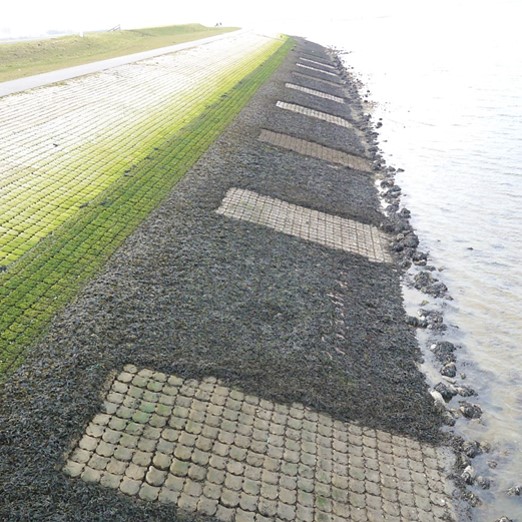|
(Nieuwe pagina aangemaakt met '{{Context VN |Model link=Bfn Conclusions ecoblock revetments }} {{Context VN show}}')
|
|
||
| Regel 1: | Regel 1: | ||
| + | |||
{{Context VN |
{{Context VN |
||
|Model link=Bfn Conclusions ecoblock revetments |
|Model link=Bfn Conclusions ecoblock revetments |
||
}} |
}} |
||
{{Context VN show}} |
{{Context VN show}} |
||
Huidige versie van 24 okt 2017 om 12:02
There were large differences in the development of seaweed coverage in the first 1.5 years after laying the blocks. The development of Fucus vesiculosus was particularly fast on BfN-hydroblocks and Hillblocks. The fact that Fucus vesiculosus was developing faster on BfN-blocks as compared to standard hydroblocks can likely be explained by water retention by the blocks. Since all blocks were produced by the same standard procedure at the same factory, it is unlikely that there are differences between the blocks other than the pits. The coverage rate of gutweed remained remarkably high throughout the first year on hydroblocks with ecotop. There may have been a competition for space between the pioneer species of gutweed and the Fucus species. Gutweed are known as pioneering species that develop on bare substratum. Gutweed are strong interference competitors, but only under conditions that are stable, as they are relatively sensitive to grazing and desiccation (Hurd et al. 2014). The ecotop seemed to stimulate gutweed growth the most, possibly by their relatively high moisture retention capacity. This might have resulted in reduced space available for brown seaweeds to settle.
The presence of amphipods strongly correlated with Fucus biomass. These algae are an important food source for them. Crustaceans like these are in turn a food source to bird species like ruddy turnstones, which are known to use dykes as foraging habitat. The rapid colonization and biomass development on several of the block types tested may therefore benefit these species. Based on the experiment, it is still hard to predict how much the revetment type influences the final seaweed community composition at the climax state. The climax community of the seaweed population on dykes is dominated by brown seaweeds (Fucus vesiculosis, Fucus spiralis, Fucus serratus and Ascophyllum nodosum) and a variety of smaller red and green algae. Ascophyllum nodosum was a dominant species on the previous dyke at Sint-Annaland before it was renovated (personal observation).
Outlook
Ongoing research at HZ includes a simulation of a disturbance event where all seaweeds on a part of each section will be completely removed using a bush trimmer (Figure 1.). The aim of this research is to gain insight into the ability of the seaweed community to recolonize the substrate after e.g. winter storms. This research will be part of the educational program of the Bachelor study Watermanagement: Aquatic Ecotechnology at the Delta Academy.
- Seaweed Ecology and Physiology: Second Edition, Hurd, Catriona L., Paul J. Harrison, Kai Bischof and Christopher S. Lobban, juli 2014.
Zie ook
- The colonization by seaweed and fauna of different revetment types at Sint-Annaland, Tholen; RAAK-PRO Building for Nature final report
- The recolonization by seaweed on different revetment types on the test site at Sint-Annaland, Tholen; Progress report of the seaweed development in the first five months after placement
- Ecological potential of mastic asphalt for rich revetments
- Risk analysis on the import of mussels from the Limfjord and the Isefjord (Denmark) to the Oosterschelde
- Oesterdam sand nourishment - ecological and morphological development of a local sand nourishment
- On the relationship between dike revetments and ecology: lessons learned for design and follow-up monitoring for asphalt covered locations
- Early colonization of algal communities on polyurethane bonded aggregate: a field and laboratory study
- Ecosystem recovery after hypoxia: what can foraminifera indicate?
- Building with Nature; from concepts to practice
- Ecosystem Services of constructed oyster reefs







